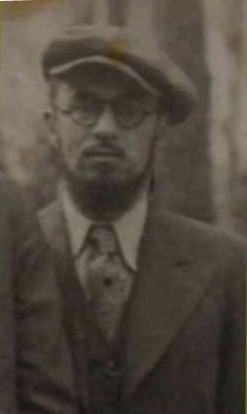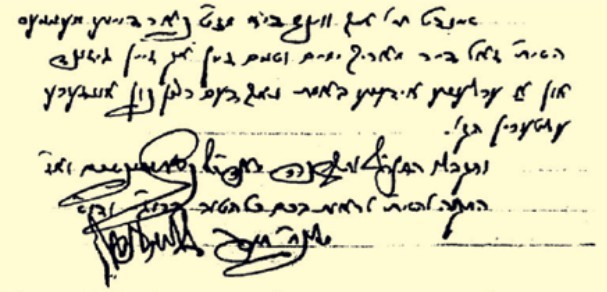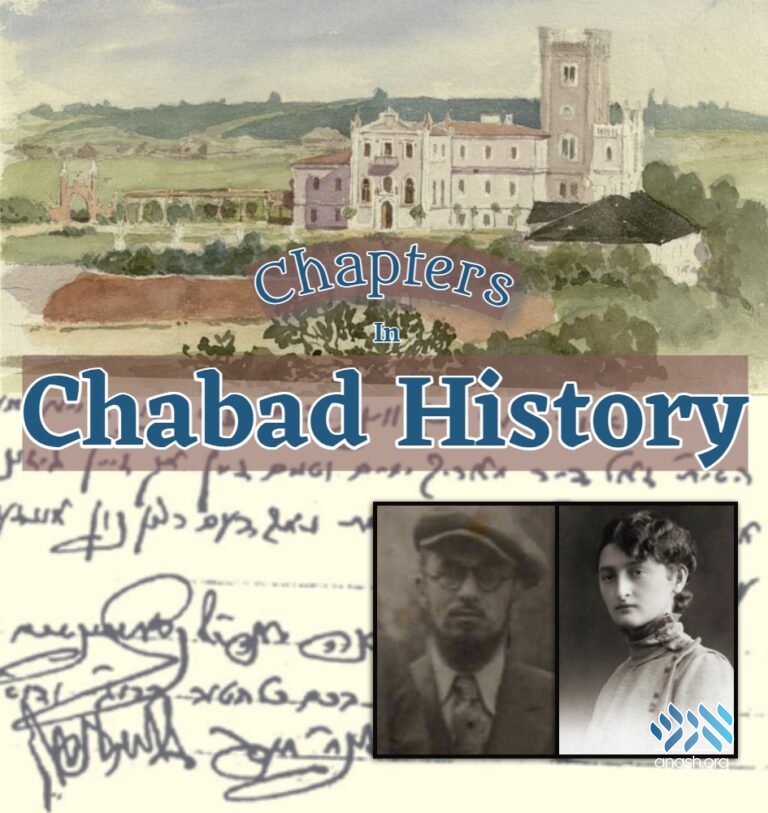Much is known about the wedding of the Rebbe and Rebbetzin, but how much do you know about the wedding of the Rebbetzin’s sister, Rebbetzin Sheina to Reb Mendel Horenstein? A fascinating installment of Chapters in Chabad History.
By Nochie Wolf
From Anash Magazine – published by Anash.org
In Shevat of 5592, Reb Yechezkel ‘Chatche’ Feigin, the Frierdiker Rebbe’s secretary, turned to Reb Yisroel Jacobson with an urgent request. The Friediker Rebbe’s daughter, Sheina was set to be married- the decision was yet to be formalized- and funds had to be raised for the wedding.
“I propose that besides for the regular Ma’amad contributors… for this collection, it would be worthwhile to increase the scope of the appeal by distributing wedding invitations as widely as possible. We should send invitations to all the members of Nusach Ari shuls and also address public letters to the shuls themselves. Perhaps this will also be an opportunity to impress upon the Shul that they have an obligation to donate a communal contribution as was the custom in days bygone. Then, when there was a wedding in Beis Rabbeinu, besides individual donations, the community would collectively send a gift called a Drosho Geshenk.

Now, although the wedding remains a secret, nonetheless, I am writing about it to a select few such as Reb Eliyahu Simpson, Reb Shlomo Aharon Kazranovsky, and perhaps Rav Lokshin. I am doing this because if one will become aware that I wrote to one person but not him, it is self-understood that this will create an unpleasant situation, and he will be right”
In a follow-up letter, he described the financial difficulties that the Friediker Rebbe was facing. “Now my friend, I implore you to read my letter slowly and meticulously and think deeply about the following matter. Can you picture the dire situation of the Rebbe; he must make a wedding when there isn’t even money for regular expenses? Can you imagine the scarcity? And already a week has passed that he is suffering from the ailment in his foot!”

Reb Chatche spent the following months galvanizing Chassidim worldwide, especially in America, encouraging them to arrange donations and organizing the practical aspects of the following months. He described this period of time in a letter to Reb Shlomo Aharon Kazarnovsky, “I would elaborate but ‘my pen is not with me’ from the mass of work I am crammed with, and which night, like days I am locked in my office dealing with. And on top of that, I must contend with the financial situation in Beis Chayenu … there is no end to the shame!”
On Lag B’omer 5592 the Tnoim between Reb Menachem Mendel Horenstein and Sheina Schneerson was held in Riga. The Friediker Rebbe said over the maamar Shir Hamaalos and in his Reshimos, the Rebbe records various stories the Friediker Rebbe related then. Invitations were then sent for the wedding which was set for Yud Sivan in the city of Landarov.
The Horenstein’s were an esteemed family who were historically connected to the Boyan Chassidus. Reb Moshe Horenstein, the Chosson’s father, married the youngest daughter of the Rebbe Maharash, Rebbetzin Chaya Mushka. It was actually the Rebbe Rashab who arranged his sister’s shidduch since the Rebbe Maharash had already passed away.

In his diary, the Friediker Rebbe recounts his visit to his uncle and aunt in Yelena where they operated a lumber business. He describes Reb Moshe’s outstanding dedication to Chassidus and that “it had a tremendous impact on many of the locals; many gifted intellectuals who were knowledgeable in secular thought but distant from Chassidus were drawn close through him.”
Around this time, a libelous lawsuit brought by an antisemitic neighbor found Reb Moshe guilty of setting fire to his own uninsured storehouse. He and his wife were forced to leave, and they moved to Otwock where he managed a Jewish orphanage, under the ‘Joint’.
Their home was always open, warm, and inviting, and quickly became a center for Anash activities. Yechiel Hadni was then a bochur in Tomchei Tmimim Otwock and later became an influential member of David Ben Gurion’s government. He became close to the Horensteins since he has no family in Otwock, and he later shared his memories of their home[1].
“I wanted to ask whether I could eat by them twice a week, but it required a lot of courage for me to knock on their door. When I finally did, Reb Moshe opened the door and invited me in. He was a tall man with noble features and because he managed the local orphanage he was sensitive to childhood struggles and was touched by my story…

I hoped that they would agree to host me for two meals a week, but Reb Moshe and his wife were stubborn and demanded I eat by them every night. I especially recall the warmth of the Rebbetzin. She treated me like another son, showered me with the goodness of her heart, and never let me feel like a stranger; I was part of the family.
Already in the first meals I joined, I realized that this family was unique… whether it was the topic of conversation, the way they conversed, or even the small details of their conduct, even the strut in their walk was different and special.
Their house became the center for all the “anshei ruach” who were connected to Chassidus. I recall how all the most prominent writers of Poland would grace Reb Moshe’s table to hear what he had to say. For example, Fishel Scheneerson, the writer and psychologist whose views became headlines in newspapers across Europe, would often frequent their home.”

Reb Mendel too was noted for his kindness and gentleness, “Reb Mendel then was a tall and handsome bochur, he was twenty-two years old and I believe he was learning in the University of Berlin. He would come home for Shabbosim and his davening and behavior during the meals made a serious impression on me. His tefillah was a genuine tefillah and his brocho was a genuine brocho, and in the spirit of Chabad, everything he did was done modestly and quietly, without any blitus.
On Shabbos after the meal, he would escort me to the Amshinover Rebbe’s home because the route went through a forest that split the two areas. Mendik never let me go on my own. It was a long walk and along the way, Mendik would inquire about my welfare and would really try to speak with me about matters that would interest someone my age.”
Rebbetzin Sheina, was the youngest daughter of the Friediker Rebbe. Already from a young age, her unique personality was noticeable, as the Friediker Rebbe writes to her “Your grandfather once said that ‘you should be healthy with years of success because you have fine qualities.’ ‘Fine qualities’ is a very honorary compliment, especially when it comes from such a person[2].”

The Rebbe told several stories about her and once related that since she was the youngest daughter, she enjoyed the attention of those at home who would often play with her. She also received much attention from the Rebbe Rashab who often inquired about her and her health[3] (it seems she had some health issues growing up). The Rebbe Rashab even presided over a “Din Torah” to adjudicate whether her chess game with the Frierdiker Rebbe was played fairly[4]. On another occasion, the Rebbe Rashab was called to decide whether the gift she received from her returning father was in fact ruined.

Sheina also played a significant role in the Friediker Rebbe’s fight against the Communist regime. The Friediker Rebbe would often take one of his daughters along with him on his trips and Sheina accompanied him on multiple of these trips. On a trip to scout for a new location for Lubavitch’s activities he took Sheina along; this was a trip the Friediker Rebbe described as taking “with great fears[5].” Her fierce dialogue with Nachmanson[6] at the time of the Friediker Rebbe’s arrest is also a testament to the strength and resourcefulness of her character.
Landarov (today, Lentvaris) was a modest town on the border of Poland and close to Vilna, with no major Jewish infrastructure. It was chosen as the location of the wedding for a number of reasons: Reb Moshe and Chaya Mushka Horenstein weren’t able to obtain visas to enter Lithuania[7], the Friediker Rebbe thought that the number of people at the Rebbe’s wedding had created unnecessary chaos[8] and the cost of a large wedding wasn’t plausible with the current financial hardships in Beis HaRav.

The Friediker Rebbe came to Landarov before Shavuos with his immediate family, his two meshamshim, Reb Dovber Grossbaum and Reb Zalman Gurary, and the hoiz bochur Moshe Aharon Margel. Some Chassidim traveled to be with the Friediker Rebbe for Shavuos, and the Rebbe too arrived then. In his zichronos, Reb Zalman recounts the events of those days and shares many amazing stories of the happenings of the time.
Throngs of Chassidim began to arrive the day or so before the wedding. A journalist who was present described the scenes of Chassidim flooding the town, “We decided to take the three-thirty train, but there were technical issues and we were forced to instead take the bus. Later we were told that even a needle’s pin could not have fit into the carriages; the train was completely packed. The officials even added another carriage, but that too became full immediately. We ran towards the buses, but here too crowds had formed….

On the way, at a fair distance from the city, we met groups of Jews, Yeshiva students, and members of various Jewish youth movements, all traveling to the Rebbe by foot… It wasn’t only Chassidim streaming to Landarov, at least two hundred youth from “Shomer Hatzair”, “Hertzaliya”, and “Beitar” [Zionist organizations] were also making the effort to participate in the joyous occasion of the Nosi Yisroel and their leader.”
Most Chassidim stayed in the Kazarma, a large building which previously served as a local military base, others rented beds in people’s homes. The crowds overflowed all the available beds and many of the Chassidim slept on the benches in the Kazarma. Even prominent and wealthy Chassidim forwent their comfort to join in the Rebbe’s simcha. Reb Zalman Gurary recounts the effect this had on his friend, Moshe Gitlis, who he had shlepped to this wedding. Moshe had left Tomchei Tmimim to learn in Litvishe Yeshivos and he later retold how this sight was part of what encouraged him to return to Lubavitch.
Tuesday, Yud Sivan, the day of the wedding arrived and the streets were full of anticipation and excitement. The above-mentioned journalist recorded the happenings of that morning, “The chaos by the center of town is indescribable: A theater company wearing yarmulkes were singing and a local band was playing Jewish songs- the energy was in the spirit of “I will be gleeful and be glad[9]”. To the tunes of the musicians, crowds were trying to obtain tickets for the wedding which were hard to come by. Even we, the journalists, only obtained tickets after much effort and preferential treatment.”
At five in the afternoon, the Kabbolas Panim was held. The Kesubah was read and signed, the kinyan was performed, and the participants drank a Lchaim (the Friediker Rebbe asked Reb Moshe that they refrain from joining). Officially, the Chuppah was called for five, but it was held up as they waited for Reb Chaim Ozer Grodzinski who was set to be mesader kiddushin. This was unique because Reb Chaim Ozer wasn’t accustomed to traveling for weddings but as he later related, “When the Rebbe sends [an invitation], one needs to go[10].”

Just before nine, Reb Chaim arrived, and while singing the Daled Bavos and clutching the burning candles, the procession headed towards the Kallah’s residence before turning to the Chuppah. All of a sudden, the clouds darkened and the rain began to fall heavily. Reb Zalman records how the Friediker Rebbe’s complexion immediately became serious and a “frightful melancholy, seriousness and tension” descended upon his face.
In his Reshimos, the Rebbe describes many of the chuppah’s details: Rebbetzin Sheina was instructed to say a lot of Tehillim, the Chuppah was held outdoors, the ring was gold and the Friediker Rebbe instructed that the impression in the ring attesting to its gold standard was to be scrapped off. The Chosson was also instructed to remove his watch, cufflinks, and valuables, and to undo the knot of his tie.
After the Chuppah, the crowd formed a procession, following the Chosson, Kallah, and their parents to the hall where they shared a moment to eat and drink something. Because of the late start, by then, it was extremely late and sunrise was only a few hours away. Following the Friediker Rebbe’s instructions, the wedding went into the next morning. Bentching and Sheva Brochos were all done after sunrise!
Sheva Brochos was not held every day, and the Rebbe records that on Wednesday, Leil Shabbos and Shabbos day there was a minyan gathered for the Sheva Brochos. Later, two interesting stories were shared about the events of the Shabbos Sehva Brochos:
By Krias Hatorah on Shabbos, a problem arose. The Horensteins are Kohanim and therefore, in order for both Reb Mendel and his father to receive an Aliyah, one would have to receive maftir. However, maftir customarily was given to the FR. In contrast to regular Chabad minhag, the Frierdiker Rebbe directed that Shvi’i be split, Reb Moshe receive the eight Aliyah, and himself maftir.
Reb Dovber Grossbaum, one of the Friediker Rebbe’s bochur-assistants, related how he forgot to bring out the Kugel by the Shabbos seudah. After bentching, the Friediker Rebbe asked the Rebbetzin why there had been no Kugel. Realizing that it had been simply forgotten, he requested everyone wash netilas yadayim again. They all returned to the table and partook in the Kugel.
A few months after the wedding, the newly married couple moved to Paris, and shortly after, the Rebbe and Rebbetzin followed them. The rest of their story is a chapter in itself, but ultimately they were killed by the Nazis ym”sh, and the Rebbe would say Kaddish liluy nishmosoh on the second day of Rosh Hashanah.
This article first appeared in Anash Magazine – published by Anash.org.
***
[1] כפר חב”ד גל’ 769
[2] ספר המאמרים תשי”א עמ’ 122
[3] אג”ק אדמו”ר הרש”ב ח”ב ע’ תשכה, תשסא, ח”ה ע, קמ ועוד
[4] מפי ר’ שמשון יוניק ונדפס בקובץ הקהל תשרי בליבואוויטש א
[5] אג”ק אדמו”ר הריי”צ ח”א ע’ תרכה
[6] סה”ש תרפ-ז ע’ 181
[7] אגרות-קודש אדמו”ר הריי”צ חלק ב ע’ תיז, ובמכתב הרי“פ מיום ט‘ אייר תרצ“ב
[8] .ימי מלך ח”א עמ’ 3. ולציין על הגנבים והשוד שהתרחשו בחתונת הרבי
[9] נוסח התפילה
[10] תשורה זירקינד-וואלף תשע”ה

This was a really gevaldik story, never heard before. Thank you.
thank you so much for another fascinating episode in the history of Lubavitch, which at least I have been totally ignorant of, can’t wait for the next one!